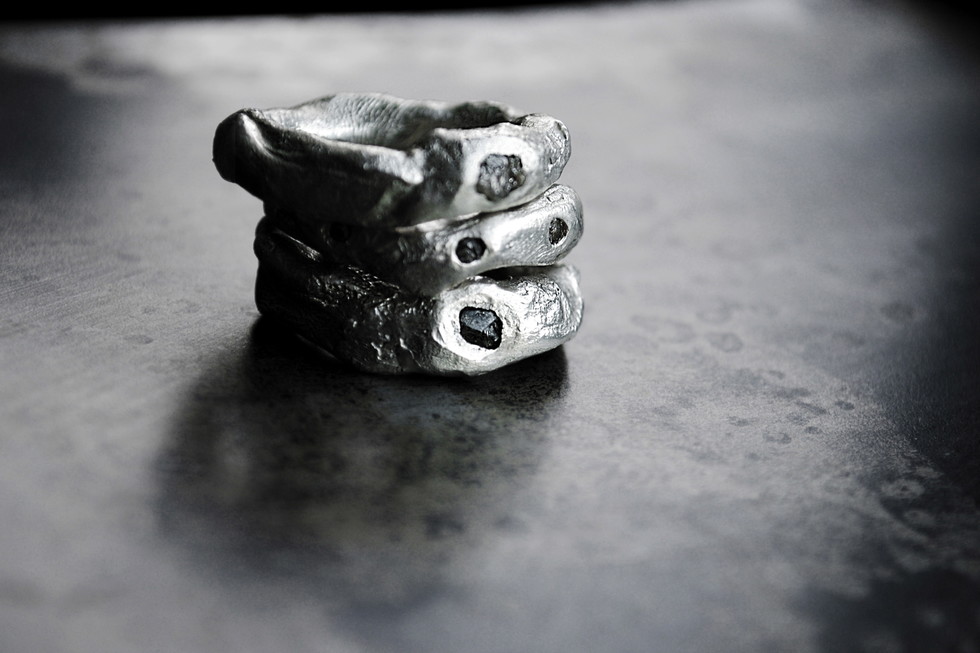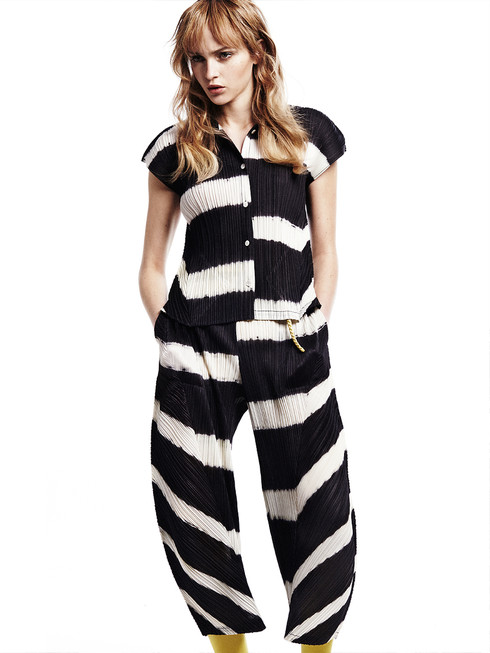IN CONVERSATION WITH XENOPHORA
Written by Felicia ErikssonXENOPHORA is the brand created by the designer Karissma Yve. Based in Detroit, she focuses in creating relics that is a step away from just being ordinary fashion jewelry. The creative process, the ancient hand made techniques and the relation between the floating poetry and the raw textures marks the aesthetics of Karissma Yve’s world.
FE: The name XENOPHORA comes from the ancient Greek meaning “bearing foreigners”, in what way does this reflects in your design?
KY: XENOPHORA holds a very foreign and anomalous spirit within the jewelry objects. I think of the silver and how I manipulate, carve and sculpt it. While the silver has its own purity and material composition, it now has a new component - a foreigner, which is me. These precious objects hold me within as its foreigner, once my hands touches the material it becomes perfectly imperfected, blistered, blackened and filled with a new essence. It is not a XENOPHORA object until it goes through a series of transitions and each and every object undoubtedly contains a piece of me.
FE: The objects seems to be more than just adornment, each piece is like a small sculpture you can wear on your body. How come you chose jewelry as a way of expression?
KY: It all starts off as a form a writing, a collection of intimate thoughts, theories and manifestations. For centuries jewelry has had many esoteric attachments to them, both the finished products and its alchemical processes. My vodouisant ancestors would tie dried herbs around there necks, stack copper or carved wood circlets engraved with symbols up to their elbows. While ancestors on my mother’s side would melt lead on a spoon, over candle fire and pour the molten metal into water. They would then read the oracle based on the form that the lead took from the rapid cooling and casting process.. this is how they told the future.
Jewelry ties both of these practices into one for me. Its an oracle and a relic worn for reasons that goes beyond what I can express. The alchemical process excites me and leaves me in awe every time I create something new.
FE: Tell me more about the techniques you’re using? How important are these for yourself and for the final product?
KY: Technique is very important and there is no final object without technique, as it is the beginning toward the end. Understanding what it is that I would want to convey is the beginning. I then must select the technique that best translates the thought into precious metal matter. Its mostly an organic process when choosing which technique works with what. Its whatever I am drawn to in that moment. Then I will either sculpt the material, carve or pour molten metal into sand or bone.
I am uncovering more and more ancient techniques and making my own techniques to proper translate my poetry very often, so it changes quite frequently. I don’t want to be too accustomed to one way of doing things. Its organic, each piece is hand-made one at a time. The possibilities for working in metal are broad and it all depends on what the piece calls for. Its like I am sourcing my thoughts and inspirations from my inner most core and then the techniques come to me and while working, the technique matures.
FE: Instead of talking about collections, you’re working around the concept of phases. The current phase of XENOPHORA is the 3rd one, called “Instead I Ransomed Ash and Bone” - where does the inspiration within this phase come from?
KY: Phase 003 Instead I Ransomed Ash and Bone, comes directly from a piece of writing that I did while in this specific phase. The inspiration comes directly from experience, as with each and every phase that I create. In this time I was journeying through this primordial ash and the current zeitgeist (which is the bone) and bridging the gaps between them.
FE: Starting out as a jewelry brand, XENOPHORA is now taking the first steps into a new realm. You recently collaborated with a designer in Detroit and created a limited collection of bags. Tell me more about the process and the product?
KY: Collaborations come as ritual unions. I’ve always wanted to adapt hardwares for handbags… Hardware that is atypical, organic yet functional and brutalistic. Upon meeting the founder of Around. Before we thought that we might create a capsule collection where we could develop something unique while maintaining our individuality. Our time designing was filled with unifying our individual perspectives. XENOPHORA being rough, brutalist, raw and primitive and Around. Before being minimal, highly constructed and almost mechanical. We wanted to create wearable objects where the hardware was not only functional but an adornment to the fleshly walls of the leather.
FE: Compare to the crazy trend obsessive fashion industry, do you feel that the jewelry industry, in some way, is standing outside that fast spinning wheel? I’m thinking about the long lasting materials and the timeless design that often characterizes jewelry?
KY: I don’t know what the fashion jewelry industry looks like. The XENOPHORA universe is more than just a jewelry brand, as my focus when creating the ‘jewelry’ objects is not trend oriented, it’s quite the contrary - its controlled by something more archaic and primitive. A conjuring of otherness, which may be otherworldly though it has its place here. With XENOPHORA I work to create an aesthetic universe - these objects are hand-made with a trueness to the materiality, though not limited to ‘just being jewelry’ I work to not change the materiality of the pieces.
Silver is silver and diamonds are diamonds. I look not to cover the materials spirit. Rather use the material as a tool or aid in capturing a specific thought and/or concept. So I communicate with the spirit of the material, I only burnish the surface until it is at its most beautiful and natural state and let it oxidize with time while letting the diamonds just be diamonds - raw, uncut or minimally cut and in its natural untreated state.
FE: What are the future holding for XENOPHORA?
KY: I try not to work within boundaries. XENOPHORA is an object based atelier - the wearable sculptural ‘jewelry’ objects is the just an artisanal beginning to a complete object universe. Some days the future does not concern me in the typical way. Many seeds have already been planted and some seeds take the form of object expansion, new experiments, more collaborations and presence.
Currently I am working on my 4th Phase, a new collaboration for developing sculptural hardwares for an Italian handbag atelier, a small brutalist and hand made Home Collection with furniture objects and dinnerwares in addition to objets d’art which will be presented during spring/summer 2016 femme Paris fashion week.. The future of XENOPHORA holds a continuation of story telling through the object and more romantic escapes of color.
http://www.xenophoraobjects.com/
























